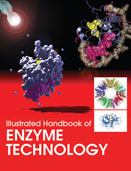Handbooks

This illustrated handbook involves production, isolation, purification and use of enzymes for the ultimate benefit of humankind. In addition, recombinant DNA technology and protein engineering involved in the production of more efficient and useful enzymes are also a part of enzyme technology. The overall goal is to develop new and more sustainable products, processes and services to meet the human needs or to improve processes to produce existing products from new raw materials and biomass.
Enzymes are the biocatalysts synthesized by living cells. They are complex protein molecules that bring about chemical reactions concerned with life. It is fortunate that enzymes continue to function when they are separated from the cells i.e. in vitro. Basically, enzymes are nontoxic and biodegradable. They can be produced in large amounts by microorganisms for industrial applications. In the field of biotechnology there are many industrial applications that result in biotech products that we use every day at home. Some of these are food science applications that utilize enzymes to produce or make improvements in the quality of different foods. In the dairy industry, some enzymes are required for the production of cheeses, yogurt and other dairy products, while others are used in a more specialized fashion to improve texture or flavor.
Illustrated Handbook of Enzyme Technology involves production, isolation, purification and use of enzymes for the ultimate benefit of humankind. In addition, recombinant DNA technology and protein engineering involved in the production of more efficient and useful enzymes are also a part of enzyme technology. In recent years, the technique of enzyme or whole cell immobilization has revolutionized the prospects of enzyme application in industry that allows exchange with, but is separated from, bulk phase in which substrate, effector or inhibitor molecules are dispersed and monitored. Therefore, theoretically, enzymes are good candidates for improved production through genetic engineering. During the past 15 years, the advances in the recombinant DNA technology have certainly helped for increasing the microbial production of commercial enzymes. It is now possible to transfer the desired enzyme genes from one organism to the other. Today, enhanced production of economically important fermentation products has benefited from targeted genetic engineering techniques to established industrial microbial strains. The formation of end- or by-products is dependent on microbial strain and the environmental conditions employed. For an optimum fermentation process, a microbial strain should be selected and developed based on the desired product. Strain development technologies include mutation and recombinant DNA technology. Growth of microorganisms and product formation are also affected by temperature, pH, dissolved oxygen, and fermentation medium composition. Therefore, the fermentation media and growth conditions need to be optimized. Moreover, the metabolic pathways should be determined. Knowledge of biochemical changes in fermented foods can help producers to manipulate the production by changing strains and/or conditions. In addition to growth conditions, types of strains, and media, fermentation modes affect the productivity. Batch, fed-batch, and continuous fermentation modes can be selected for high productivity. Fed-batch and continuous modes can overcome the substrate limitation during fermentation processes. Higher productivity can also be achieved by cell immobilization, which results in increases in the biomass concentration in the bioreactor, and thus an increased concentration of biocatalysts in the reactor.
Illustrated Handbook of Enzyme Technology also focuses on the optimization of media and growth conditions and criteria for microbial strain selection and strain development are summarized. The strains, production conditions, and biochemical changes involved in the production of fermented foods are explained. Immobilized fermentation principles and basic recovery methods are also summarized.